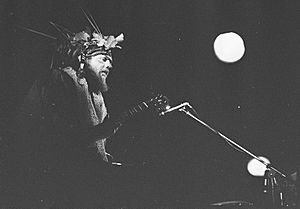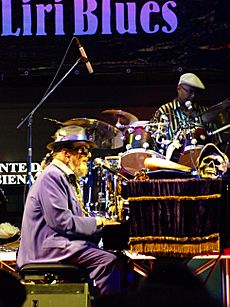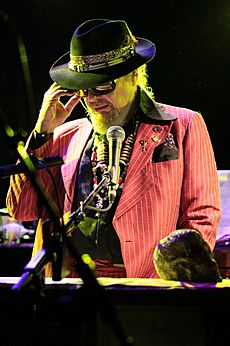Dr. John facts for kids
Quick facts for kids
Dr. John
|
|
|---|---|
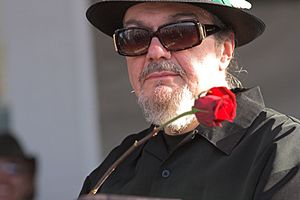
Dr. John at the 2007
New Orleans Jazz & Heritage Festival |
|
| Background information | |
| Birth name | Malcolm John Rebennack Jr. |
| Also known as |
|
| Born | November 20, 1941 New Orleans, Louisiana, U.S. |
| Died | June 6, 2019 (aged 77) New Orleans, Louisiana, U.S. |
| Genres | |
| Occupation(s) | Musician |
| Instruments |
|
| Years active | 1950s–2019 |
| Labels |
|
| Associated acts |
|
Malcolm John Rebennack Jr. (born November 20, 1941 – died June 6, 2019), known as Dr. John, was an American singer and songwriter. His music was a cool mix of New Orleans blues, jazz, funk, and R&B.
He started as a studio musician in the late 1950s. He became famous in the late 1960s after his album Gris-Gris came out. Dr. John was known for his exciting stage shows. These shows were inspired by old-time medicine shows, Mardi Gras costumes, and voodoo traditions. He made 30 studio albums and 9 live albums. He also played on thousands of other musicians' songs. In 1973, his song "Right Place, Wrong Time" became a top-10 hit.
Contents
Early Life and Music Beginnings
Malcolm John Rebennack Jr. was born in New Orleans, Louisiana, on November 20, 1941. His family had roots from different parts of Europe. His dad owned an appliance shop where he fixed radios and sold records. Young Malcolm grew up listening to music. His grandfather sang old minstrel show tunes, and many family members played piano.
He didn't take music lessons until he was a teenager. His father introduced him to jazz legends like King Oliver and Louis Armstrong. These artists later inspired Dr. John's 2014 album, Ske-Dat-De-Dat: The Spirit of Satch. As a teenager, he got to visit recording studios. He saw rock artists like Little Richard and Guitar Slim at work. Soon, he started playing guitar in New Orleans clubs with local musicians.
When he was about 13, Rebennack met Professor Longhair, a famous musician. He was impressed by Professor Longhair's style and soon started playing with him. This was the start of his life as a professional musician. He joined the musicians' union in 1957.
At 16, Rebennack became a producer at Ace Records. He worked with many artists there, including James Booker and Earl King. He was still a student at Jesuit High School but played in nightclubs. The school didn't like this, so he left in 1954 to focus completely on music.
In the late 1950s, Rebennack played with local bands in New Orleans. His first rock and roll song, "Lights Out" (1957), was a regional hit. He also had a hit instrumental song called "Storm Warning" in 1959.
Around 1960, he hurt his left hand while playing guitar. After this injury, he started playing bass guitar. Later, the piano became his main instrument. He developed a unique piano style influenced by Professor Longhair.
When he moved to Los Angeles, he became a busy studio musician. He was part of a group called the "Wrecking Crew". He played on songs for artists like Sonny & Cher, Canned Heat, and Frank Zappa.
Becoming Dr. John, The Night Tripper (1968–1971)
In the late 1960s, Rebennack became famous as a solo artist. He created the character "Dr. John, The Night Tripper." This act mixed New Orleans rhythm and blues with psychedelic rock. His stage shows were very colorful and included special costumes and headdresses. He said the name "Doctor" came from friends calling him that.
His first album, Gris-Gris (1968), was a blend of voodoo rhythms and New Orleans music. Rolling Stone magazine listed it as one of the "500 Greatest Albums of All Time."
He released three more albums in a similar style: Babylon (1969), Remedies (1970), and The Sun, Moon & Herbs (1971). During this time, Dr. John toured a lot. Famous musicians like Eric Clapton and Mick Jagger even played on his album The Sun, Moon, and Herbs. This album also marked a change in his music. He started moving from his "Night Tripper" voodoo style to more traditional New Orleans R&B and funk. His next album, Dr. John's Gumbo, became very popular.
Gumbo, In the Right Place, and Desitively Bonnaroo (1972–1974)
Dr. John is well-known for his music from 1972 to 1974. His 1972 album, Dr. John's Gumbo, featured many classic New Orleans R&B songs. He wrote that the album was a tribute to the music he grew up with. The song "Iko Iko" from the album became a hit, reaching No. 71 on the Billboard chart. Rolling Stone also listed Dr. John's Gumbo as one of the 500 greatest albums ever.
With Gumbo, Dr. John explored music beyond his psychedelic voodoo shows. He still kept some of that style, but he also focused on traditional New Orleans R&B. He later said he stopped the "hoodoo show" and started a new act with Mardi Gras songs from Gumbo.
In 1973, Dr. John released In the Right Place. This album was produced by Allen Toussaint and featured the band The Meters. It became a very important New Orleans funk album. Dr. John said it had a more "straight-ahead dance feel." The album reached No. 24 on the Billboard chart. The song "Right Place, Wrong Time" was a huge hit, reaching No. 9 on the Billboard Hot 100. It's still his most famous song today.
His next album, Desitively Bonnaroo (1974), also featured Allen Toussaint and The Meters. The famous Tennessee festival got its name from this album. While it was similar to In the Right Place, it didn't become as popular. It did have a single, "(Everybody Wanna Get Rich) Rite Away," which reached No. 92. This was his last pure funk album for a while, but funk music always influenced his work.
In the mid-1970s, Dr. John started working with songwriter Doc Pomus. They wrote many songs together for Dr. John and other artists like B.B. King. Dr. John and Doc Pomus were very close friends.
In 1976, Dr. John performed "Such a Night" at The Band's farewell concert, which was filmed for the movie The Last Waltz. In 1979, he played guitar on Professor Longhair's last album, Crawfish Fiesta.
Later Music and Collaborations
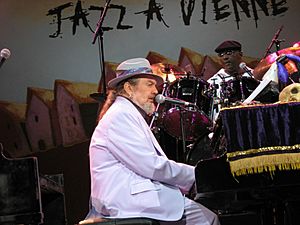
By the mid-1970s, Dr. John's music included blues, New Orleans R&B, and classic songs. In 1981 and 1983, he released two solo piano albums, Dr. John Plays Mac Rebennack and The Brightest Smile in Town. On these albums, he played many of his own boogie-woogie songs.
Dr. John was also a very busy session musician. He sang backup for The Rolling Stones on "Let It Loose" in 1972. He also played with Carly Simon, James Taylor, and Neil Diamond. He co-produced Van Morrison's 1977 album A Period of Transition. He also played on albums for Levon Helm and Rickie Lee Jones.
His music was used in many movies, like National Lampoon's European Vacation (1985) and Colors (1988). In 1992, Dr. John released Goin' Back to New Orleans, which featured many classic New Orleans songs. Musicians like Aaron Neville and Al Hirt played on this album.
Dr. John also sang the "Luv dat chicken..." jingle for Popeyes Chicken & Biscuits. He sang the theme song ("My Opinionation") for the TV show Blossom. He also sang "Do You Know What It Means to Miss New Orleans?" with Harry Connick Jr. in 1990.
He appeared in films like Martin Scorsese's The Last Waltz and Blues Brothers 2000. In Blues Brothers 2000, he performed "How Blue Can You Get" and "New Orleans." His version of "Season of the Witch" was also in that movie. In 1996, he sang "Cruella de Ville" for the movie 101 Dalmatians.
He wrote the music for the 1982 film Cannery Row. His hit song "Right Place Wrong Time" was used in movies like Dazed and Confused and Sahara.
From 1989 to 1991, Dr. John toured with the first Ringo Starr & His All-Starr Band. This band included famous musicians like Levon Helm and Joe Walsh.
In 1997, he played piano on the Spiritualized song "Cop Shoot Cop." He also appeared on the charity single "Perfect Day" by Lou Reed.
After Hurricane Katrina hit New Orleans in 2005, Dr. John performed to help victims. He released an album called Sippiana Hericane to raise money for New Orleans musicians and charities. In 2006, he sang the national anthem at Super Bowl XL as a tribute to New Orleans. He also performed at the Grammy Awards of 2006.
He sang the opening theme music for the PBS children's show Curious George, which started in 2006.
In 2008, Dr. John released City that Care Forgot, an album about the damage Hurricane Katrina caused in New Orleans. This album won a Grammy Award.
In the 2009 Disney movie The Princess and the Frog, Dr. John sang the opening song, "Down in New Orleans". He was also the King of the Krewe du Vieux for the 2010 New Orleans Mardi Gras season.
In 2011, he worked with Hugh Laurie on the song "After You've Gone." That same year, Dr. John was inducted into the Rock and Roll Hall of Fame.
In 2012, Dr. John released Locked Down, which he made with Dan Auerbach of The Black Keys. The album got great reviews and won a Grammy Award.
In 2014, Dr. John released Ske-Dat-De-Dat: The Spirit of Satch, a tribute album to Louis Armstrong. He said Louis Armstrong came to him in a dream and told him to play his music "your way." That spring, a concert called "The Musical Mojo of Mac" was held in New Orleans to honor Dr. John. Bruce Springsteen performed his hit song "Right Place, Wrong Time."
Dr. John also recorded "Let 'Em In" for a Paul McCartney tribute album. He was interviewed by Dave Grohl for the Foo Fighters' TV series Sonic Highways.
In 2017, Dr. John performed "Right Place Wrong Time" in a video for the NBA All-Star Game. He also joined The Last Waltz 40th Anniversary Tour, performing "Such a Night" again. His first single, "Storm Warning," was featured on the Logan Lucky soundtrack.
In November 2017, the New Orleans City Council declared "Mac Month" and "Dr. John Day" to honor him. His birth date was corrected in 2018. It was found he was born on November 20, 1941, not November 21, 1940. He had added a year to his age when he was young to get into clubs.
In 2022, a country & western album called Things Happen That Way was released after his death. It featured guests like Aaron Neville and Willie Nelson. This album was nominated for a Grammy.
Musical Style
Dr. John was known for taking the sounds of New Orleans blues, jazz, and R&B and making them new. Billboard described him as a soul, funk, and boogie-woogie musician. He became a New Orleans music icon by bringing old traditions to new audiences. His style is also called New Orleans rhythm and blues and swamp rock.
Personal Life and Death
On June 6, 2019, Dr. John passed away from a heart attack. His family shared that he died at dawn. They said he created a special mix of music that always had New Orleans at its heart.
Awards and Honors
Dr. John won six Grammy Awards.
- 1989: Best Jazz Vocal Performance for "Makin' Whoopee" with Rickie Lee Jones
- 1992: Best Traditional Blues Album for Goin' Back To New Orleans
- 1997: Best Rock Instrumental Performance for "SRV Shuffle"
- 2000: Best Pop Collaboration With Vocals for "Is You Is, Or Is You Ain't (My Baby)" with B.B. King
- 2008: Best Contemporary Blues Album for City That Care Forgot
- 2013: Best Blues Album for Locked Down
He was inducted into the Rock and Roll Hall of Fame in March 2011 by singer John Legend.
In May 2013, he received an honorary doctorate from Tulane University. His album Things Happen That Way was nominated for a Grammy in 2022.
Film and TV Appearances
- Soundstage - New Orleans Swamp (1974) – as himself
- The Last Waltz (1978) – as himself, performing "Such A Night"
- SCTV (1981) – as himself
- Late Night with David Letterman (various episodes, 1982–1992) – as himself
- Yakety Yak, Take it Back (1991) – as himself and the voice of Yakety Yak
- Touched by an Angel (1996) – as himself (2 episodes)
- VH1 Duets - Eric Clapton and Dr. John (1996) – as himself
- Blues Brothers 2000 (1998) – as himself
- Treme (HBO Series, 2010–2013) – as himself
- Top Chef (2013) – as himself (guest judge)
- NCIS: New Orleans (2015) – as himself (1 episode)
- One Note at a Time (2018) – as himself
Music Albums
Albums by Dr. John
- Gris-Gris (1968)
- Babylon (1969)
- Remedies (1970)
- The Sun, Moon & Herbs (1971)
- Dr. John's Gumbo (1972)
- In the Right Place (1973)
- Desitively Bonnaroo (1974)
- Hollywood Be Thy Name (1975)
- City Lights (1978)
- Tango Palace (1979)
- Dr. John Plays Mac Rebennack, Vol. 1 (1982)
- The Brightest Smile in Town (Dr. John Plays Mac Rebennack, Vol. 2) (1983)
- In a Sentimental Mood (1989)
- Goin' Back to New Orleans (1992)
- Brer Rabbit and Boss Lion (1992) – a children's album
- Television (1994)
- Afterglow (1995)
- Anutha Zone (1998)
- Duke Elegant (2000) – a tribute to Duke Ellington
- Creole Moon (2001)
- N'Awlinz: Dis Dat or d'Udda (2004)
- Sippiana Hericane (2005)
- Mercernary (2006) – a tribute to Johnny Mercer
- City That Care Forgot (2008)
- Curious George: A Very Monkey Christmas - Music from the Motion Picture (2009)
- Tribal (2010)
- Locked Down (2012)
- Ske-Dat-De-Dat: The Spirit of Satch (2014) – a tribute to Louis Armstrong
- Things Happen That Way (2022)
Live Albums
- Hollywood Be Thy Name (1975)
- Such a Night! Live in London (1984)
- On a Mardi Gras Day (1990) – with Chris Barber
- Trippin' Live (1997)
- All By Hisself: Live at The Lonestar (2003)
- Live at Montreux 1995 (2005)
- Right Place, Right Time (Live at Tipitina's - Mardi Gras '89) (2006)
- Live in Sweden 1987 (2016) – with Johnny Winter
- The Musical Mojo of Dr. John: Celebrating Mac and His Music (2016)
With Bluesiana Triangle
- Bluesiana Triangle (1990) – with Art Blakey and David Newman
- Bluesiana II (1991) – with David Newman and Ray Anderson
Compilation Albums
- The Ultimate Dr. John (1987)
- Mos' Scocious: The Dr. John Anthology (1993)
- The Very Best of Dr. John (1995)
- 'Right Place Wrong Time' And Other Hits (1997)
- The Essentials (2002)
- Storm Warning (The Early Sessions of Mac 'Dr. John' Rebennack) (2004)
- The Best of the Parlophone Years (2005)
- The Definitive Pop Collection (2006)
- Dr. John: Original Album Series (2009)
- The Atco/Atlantic Singles 1968–1974 (2015)
- The Atco Albums Collection (2017)
- An Introduction to Dr. John (2019)
Images for kids
See also
 In Spanish: Dr. John para niños
In Spanish: Dr. John para niños


